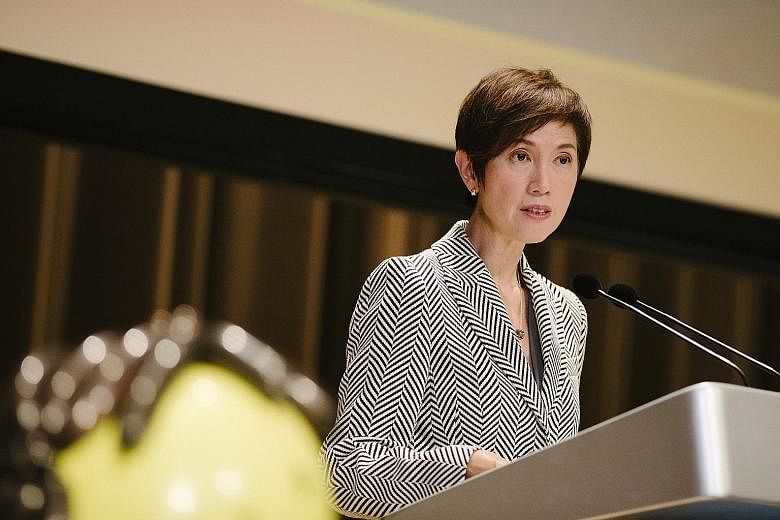Security agencies in Singapore can get funding of up to $30,000 a year to go digital, in a move to push them up the technology ladder and rely less on manpower.
They will also be given a step-by-step guide on which technology to use at each stage of their transformation under a Security Industry Digital Plan launched yesterday.
The plan is prompted by the low number of firms that use basic technology in their operations, like automated visitor management, customised smartphones for patrols and closed-circuit television cameras that analyse data. There are about 240 security firms here.
"At most, 30 per cent use one of them. In other words, we are still very far from a technology-enabled future of the industry," said Second Minister for Home Affairs Josephine Teo, who launched the plan at the Security Officers' Day Awards Ceremony at NTUC Centre in Marina Boulevard.
The goal is to double the number of security agencies that adopt technology in the next two years. And by 2025, these technologies should be a "norm and no longer the exception", added Mrs Teo, who is also the Manpower Minister.
Under the new plan, developed by the Infocomm Media Development Authority and the Home Affairs Ministry, smaller security firms will follow a three-stage road map of technology solutions.
-
Push for buyers to focus on outcomes
-
The Government is leading the way in putting out security service tenders for outcome-based contracts, with agencies like JTC Corporation (JTC) and the Singapore Land Authority (SLA) doing so recently, said Second Minister for Home Affairs Josephine Teo yesterday.
Mrs Teo said good progress has been made since the target was set earlier this year for most government agencies to adopt outcome-based security contracts by 2020. She was speaking at the Security Officers' Day Awards Ceremony, where the Security Industry Digital Plan was launched.
"We have engaged two major government buyers - MOE (Ministry of Education) and HDB - whose security contracts are due for renewal over the next year, to adopt outcome-based security contracts," she said at the event held at NTUC Centre.
Mrs Teo said that the annual security contract value for the four agencies - JTC, SLA, MOE and HDB - was more than $70 million.
She urged buyers of security services to adapt to the manpower crunch by adopting outcome-based solutions instead of manpower-based ones, and said a guide has been developed to help in this regard.
Developed by the Home Affairs Ministry in consultation with stakeholders, the Guide for Outcome-Based Security Contracts provides the principles and the templates for service buyers to adopt in procurement contracts at every stage of the tender process. Training on the use of the guide will be available by the end of this year.
At a briefing earlier this week on the Security Industry Digital Plan, Security Association of Singapore president Raj Joshua Thomas said outcome-based contracts were a "rarity".
He said buyers of security services often look at manned guarding and technology separately. "We want to encourage them to look at them together, so you can get the synergy of manpower and technology."
Tan Tam Mei
The first stage lists basic technology, such as visitor management systems, customised smartphones to report incidents and track officers, and surveillance cameras that can analyse data.
These are building blocks every security agency needs to stay competitive in the future, said Mrs Teo.
The next two stages identify technology for more advanced security firms, like the use of robotics or cluster guarding, where a group of guards manage security for multiple buildings.
Mrs Teo is convinced that in making the decisive shift to use technology and move away from the manpower-intensive model, "our security officers will deliver better security but with a leaner team".
She added: "They will use more sophisticated 'hardware', but the key will be the 'software' of people and processes, which ensure technology is used in a meaningful way."
To help firms with the upfront cost of adopting technology, at least $7 million will be set aside by Enterprise Singapore to help kick-start the process.
Through the Productivity Solutions Grant for the industry, companies can tap pre-approved digital solutions given in the new plan. The grant will support 50 per cent of qualifying costs, capped at $30,000 per firm each year.
Mrs Teo said the pre-approved solutions mean firms can choose technology proven to be reliable and cost-effective.
Also, in the pipeline is a technical reference for video analytics systems that will set a benchmark for quality and reliability, to help buyers and service providers.
It will give specifications for such aspects as selection, installation and operation of the systems. The systems are a key solution to reduce manpower, detect incidents and monitor multiple areas simultaneously.
Security Association of Singapore president Raj Joshua Thomas, who is helping to develop the technical reference, said it will be ready by the end of next year.
Among the 103 award winners at yesterday's event was senior security supervisor Kenny Ng, 52, who was recognised for adapting to technology on the job.
He said: "I had my fears at first. But after learning computer skills to operate the new technology, my job became more interesting and challenging."
He also got a pay rise.


